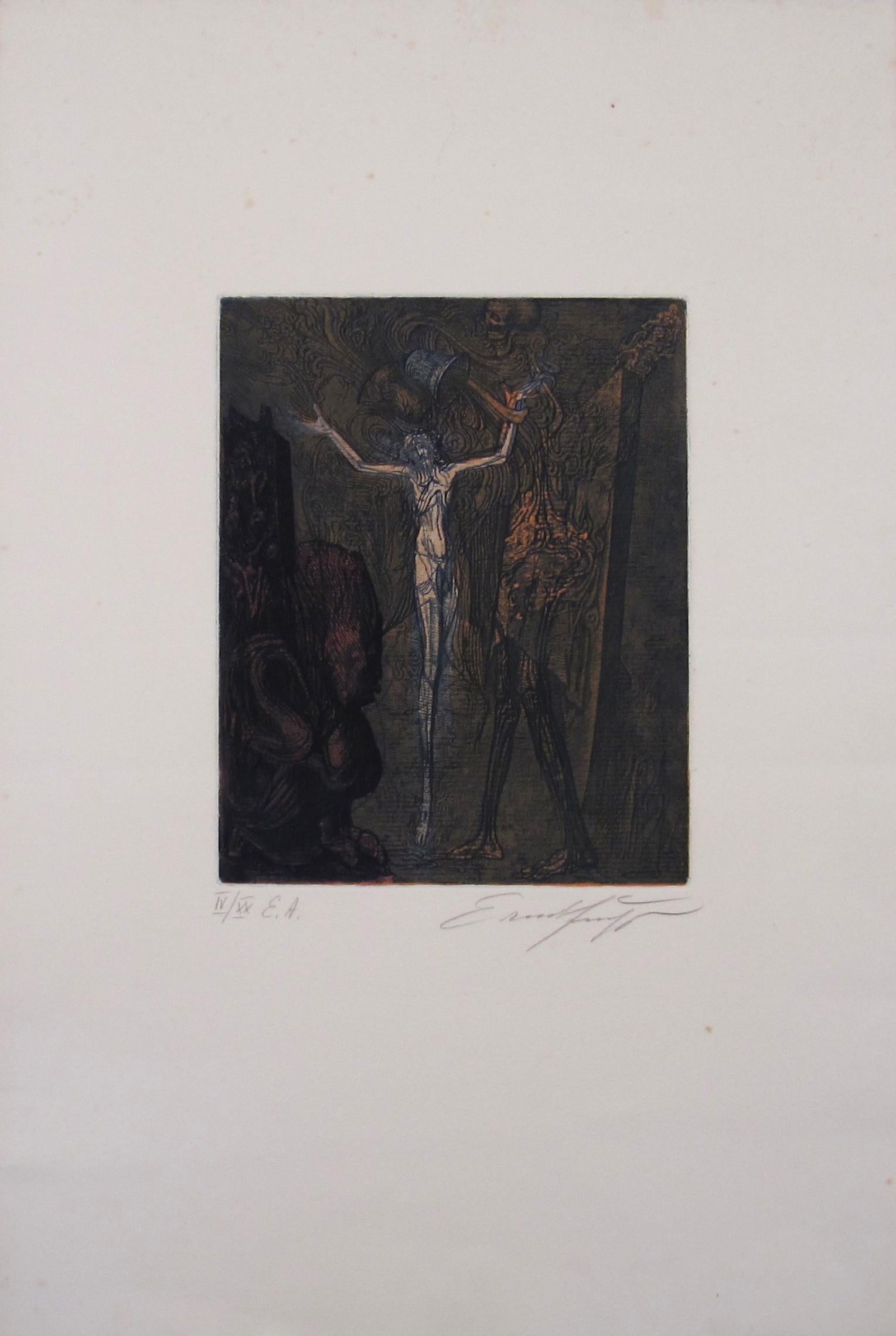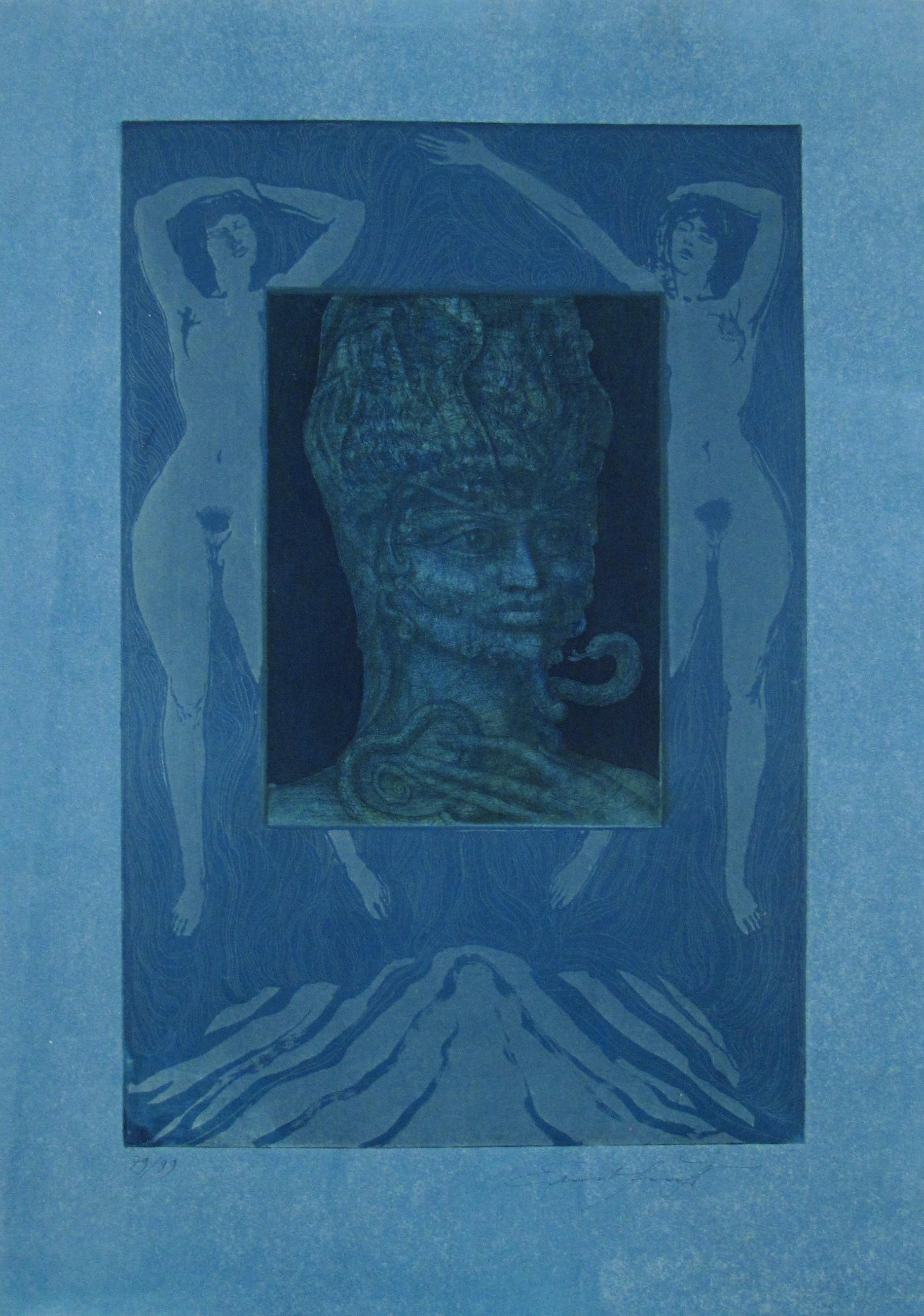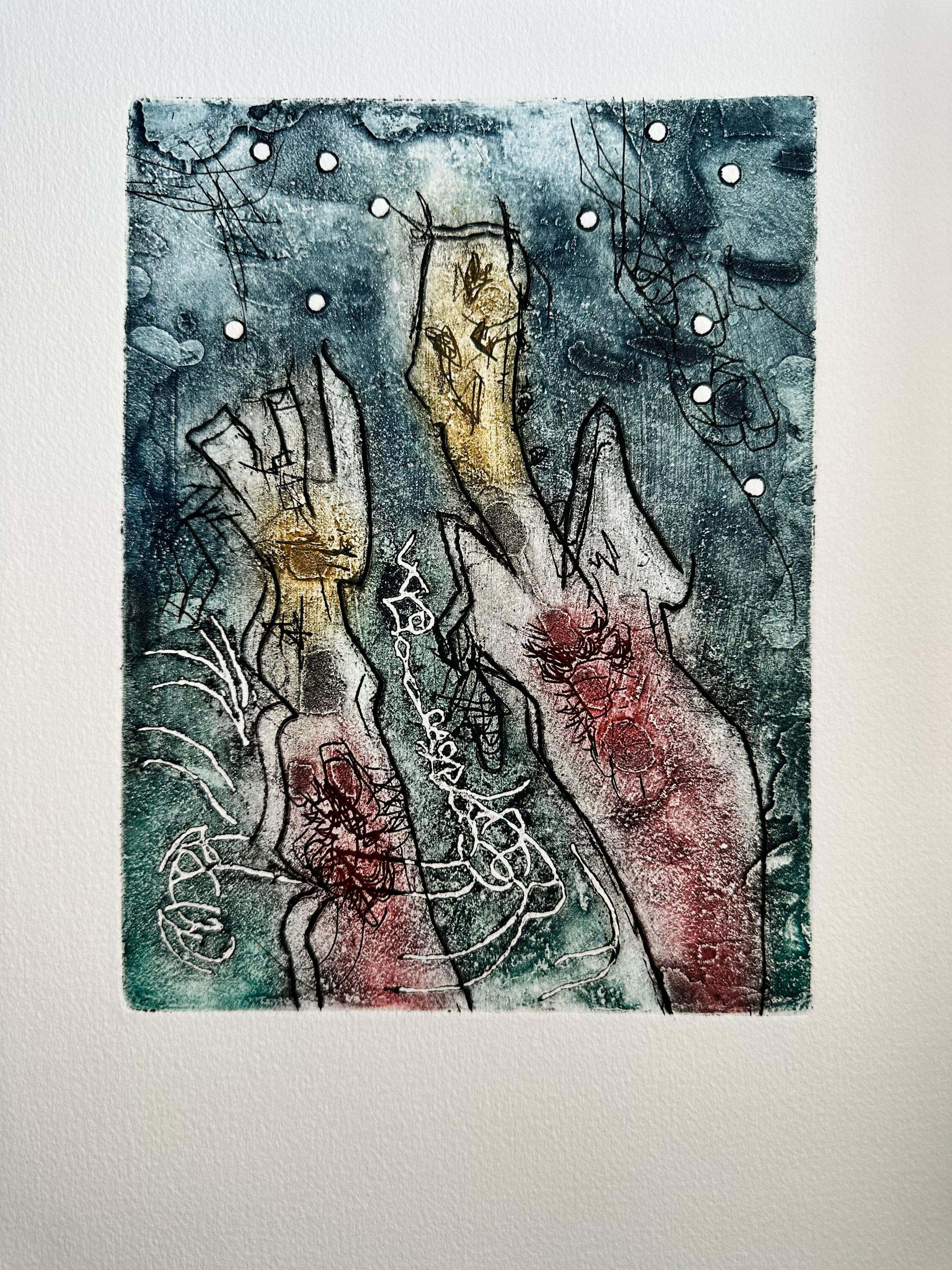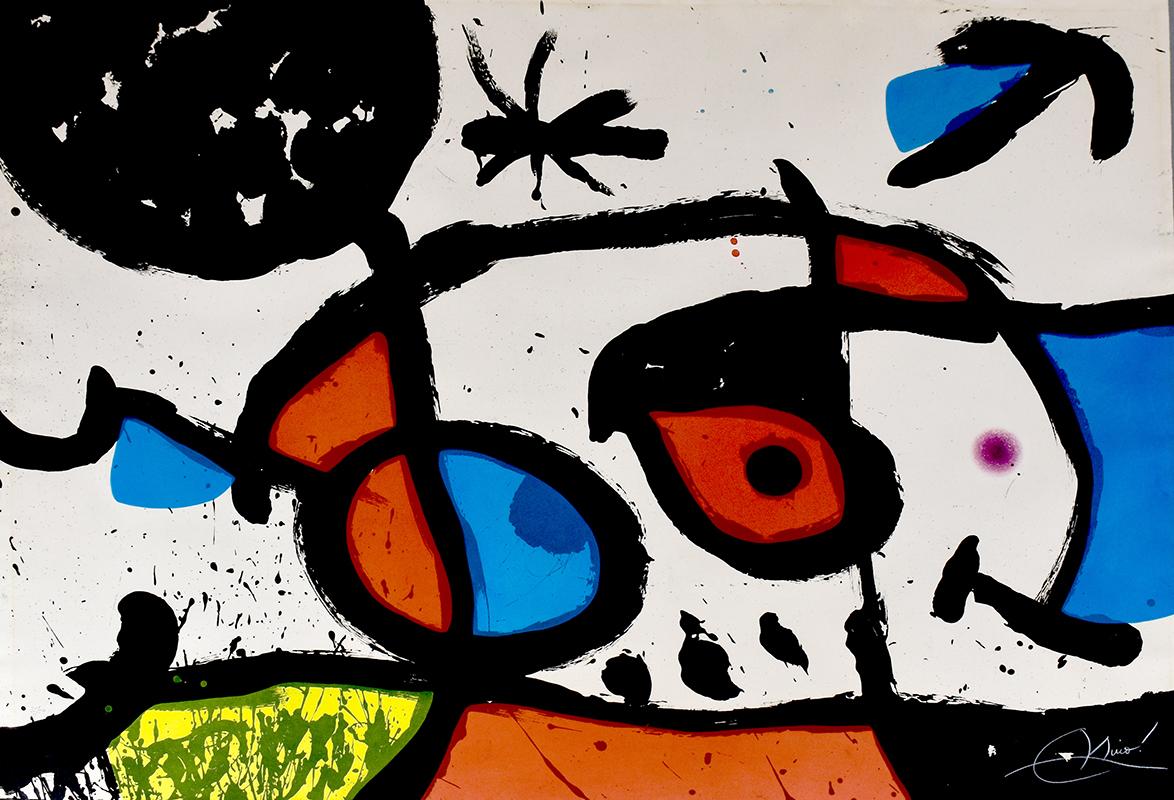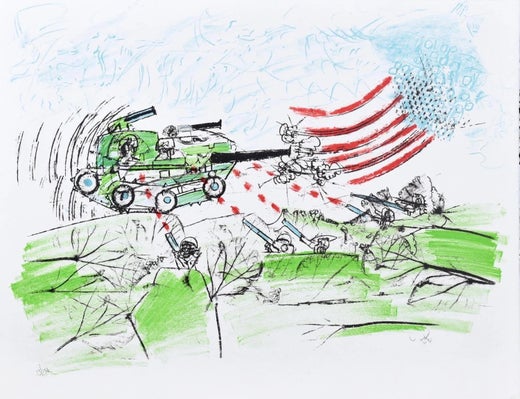Roberto Matta"Centre Noeuds" planche #101974
1974
About the Item
- Creator:Roberto Matta (1911-2002, Chilean)
- Creation Year:1974
- Dimensions:Height: 24 in (60.96 cm)Width: 17.5 in (44.45 cm)Depth: 0.01 in (0.26 mm)
- Medium:
- Movement & Style:
- Period:
- Condition:
- Gallery Location:San Francisco, CA
- Reference Number:
Roberto Matta
“The function of art,” the Surrealist Roberto Matta once stated, “is to unveil the enormous economic, cultural and emotional forces that materially interact in our lives and that constitute the real space in which we live.” In his paintings, Matta sought to expose those forces through the Surrealist practice of automatism, creating work in a free-associative state intended to conjure the unconscious.
After studying architecture in his native Chile, Matta, then 22, chose to pursue the field in Paris, where he mingled with stars of the avant-garde like Gertrude Stein, Salvador Dalí and Walter Gropius. In the late 1930s, he abandoned Paris, together with his job at Le Corbusier’s studio and (for a time) his career, for modern art’s new epicenter, New York City. There, he became a colleague of art legends like Marcel Duchamp and Arshile Gorky.
Although celebrated primarily for his work as a painter, Matta was an equally talented furniture designer. His furniture pieces, like his artworks, are the stuff of dreams. The back of his totem chair, for example, is composed of smiling, cartoonish creatures stacked on top of each other. In his MAgriTTA armchair, the top half of a plush green apple sticks out of large black bowler in homage to its namesake, the Belgian Surrealist René Magritte.
But perhaps the piece that most truly embodies his artistic philosophy is his 1966 Mallite modular system: a collection of spongy, undulating sofas and lounges that can be fitted together to form a puzzle-like room divider. The work, an original edition of which is in MoMA’s permanent collection, has in recent decades been a hard-to-find collectors’ item — until 2019, when Italian design brand Paradisoterrestre issued a reedition, available through Duplex.
Browse Roberto Matta's paintings and furniture designs on 1stDibs.
- ShippingRetrieving quote...Ships From: San Francisco, CA
- Return PolicyA return for this item may be initiated within 7 days of delivery.
- "Centre Noeuds" planche #3By Roberto MattaLocated in San Francisco, CAThis artwork titled "Centre Noeuds" plate #3 1974, is an original color etching with aquatint on Japan nacre paper by renown Chilean artist Roberto Sebastian Matta, 1911-2002. It is ...Category
Mid-20th Century Surrealist Abstract Prints
MaterialsAquatint
- "Centre Noeuds" planche #8By Roberto MattaLocated in San Francisco, CAThis artwork titled "Centre Noeuds" plate #8 1974, is an original color etching with aquatint on Japan nacre paper by renown Chilean artist Roberto Sebastian Matta, 1911-2002. It is ...Category
Mid-20th Century Surrealist Abstract Prints
MaterialsAquatint
- "Centre Noeuds" planche #5By Roberto MattaLocated in San Francisco, CAThis artwork titled "Centre Noeuds" plate #5, 1974, is an original color etching with aquatint on Japan nacre paper by renown Chilean artist Roberto Sebastian Matta, 1911-2002. It is...Category
Mid-20th Century Surrealist Abstract Prints
MaterialsAquatint
- "Centre Noeuds" planche #9By Roberto MattaLocated in San Francisco, CAThis artwork titled "Centre Noeuds" plate #9, 1974, is an original color etching with aquatint on Japan nacre paper by renown Chilean artist Roberto Sebastian Matta, 1911-2002. It is...Category
Mid-20th Century Surrealist Abstract Prints
MaterialsAquatint
- "Centre Noeuds" planche #1By Roberto MattaLocated in San Francisco, CAThis artwork titled "Centre Noeuds" plate #1, 1974, is an original color etching with aquatint on Japan nacre paper by renown Chilean artist Roberto Sebastian Matta, 1911-2002. It is...Category
Mid-20th Century Surrealist Abstract Prints
MaterialsAquatint
- "Centre Noeuds" planche #4By Roberto MattaLocated in San Francisco, CAThis artwork titled "Centre Noeuds" plate #4, 1974, is an original color etching with aquatint on Japan nacre paper by renown Chilean artist Roberto Sebastian Matta, 1911-2002. It is...Category
Mid-20th Century Surrealist Abstract Prints
MaterialsAquatint
- Ernst Fuchs Jesus Crucifixion Aquatint Vienna Fantastic Realism Austria 1972By Ernst FuchsLocated in Meinisberg, CHErnst Fuchs (Austrian, 1930 - 2015) Jesus speaking from the cross A rare Artist proof sheet from the Folio “Jean Paul. Die Rede des toten Christus vom Weltgebaude herab, dass kein Gott sei”, published in 1972 by Propyläen, Berlin, Germany. • Aquatint etching on French Arches paper (watermarked) • Sheet ca. 57 x 38 cm • Plate, ca. 24.7 x 19.7 cm • Signed bottom right • Inscribed in pencil bottom left: IV/XX E. A. (Print No. 4 out a run of twenty, Épreuve d'artiste (Artist’s proof) Worldwide shipping is complimentary - There are no additional charges for handling & delivery. Ernst Fuchs was an Austrian painter...Category
1970s Surrealist Abstract Prints
MaterialsInk, Archival Paper, Aquatint
- Ernst Fuchs Sphinx in Pharao Surreal Color Etching Vienna Fantastic Realism 1967By Ernst FuchsLocated in Meinisberg, CHErnst Fuchs (Austrian, 1930 - 2015) Sphinx in Pharao Sheet Nr. 6 from the Folio “Die Sieben Bilder und Sprüche der Sphinx”, published in Autumn of 1967 by Galerie Sydow in Frankfurt, Germany. • Aquatint Etching • Ed. 79/99 • Sheet ca. 59 x 41.5 cm • Plate signed • Signed & numbered by the artist in pencil Worldwide shipping is complimentary - There are no additional charges for handling & delivery. Ernst Fuchs was an Austrian painter, draftsman, printmaker, sculptor, architect, stage designer, composer, poet, and one of the founders of the Vienna School of Fantastic Realism. I discovered him through H.R. Giger ‘s work, who himself was greatly inspired by the creations of Fuchs and on several occasions exhibited his friend ‘s art in his museum, the Château St-Germain, Gruyères, Switzerland. I actually own the original folio box...Category
1960s Surrealist Abstract Prints
MaterialsPaper, Ink, Aquatint, Etching
- Sparire I Enzo Cucchi large scale abstract dream scape etching with screeprintBy Enzo CucchiLocated in New York, NYSparire means "to disappear" in Italian. This large-scale, dreamlike print spans almost ten feet. Enzo Cucchi Sparire 1, 1988 Color etching, aquatint and silkscreen 30 1/2 × 118 in ...Category
1980s Surrealist Abstract Prints
MaterialsScreen, Etching, Aquatint
- Theorbes et BelieresBy Roberto MattaLocated in Wilton, CTBeautiful example of Roberto Matta's book with 1 full color/ full page engraving and 4 black and white vignettes. On Arches. Signed on the justification page by the author and the ...Category
1990s Surrealist Abstract Prints
MaterialsEngraving, Aquatint
- De trace de pas de trace de…By Roberto MattaLocated in Fairlawn, OHSigned in pencil lower right Color etching with aquatint From: Monsour and Matta, Les Damnations, 1966 (11 plates, this one of 7 hors text images) Edition: 85 portfolios in the re...Category
1960s Surrealist Abstract Prints
MaterialsEtching, Aquatint
- The Convict and his CompanionBy Joan MiróLocated in London, GBJOAN MIRÓ 1893-1983 Montroig 1893-1983 Mallorca (Spanish) Title: The Convict and his Companion Le Bagnard et sa Compagne, 1975 Technique: Original Hand Signed and Numbered Etchi...Category
1970s Surrealist Abstract Prints
MaterialsEtching, Aquatint
